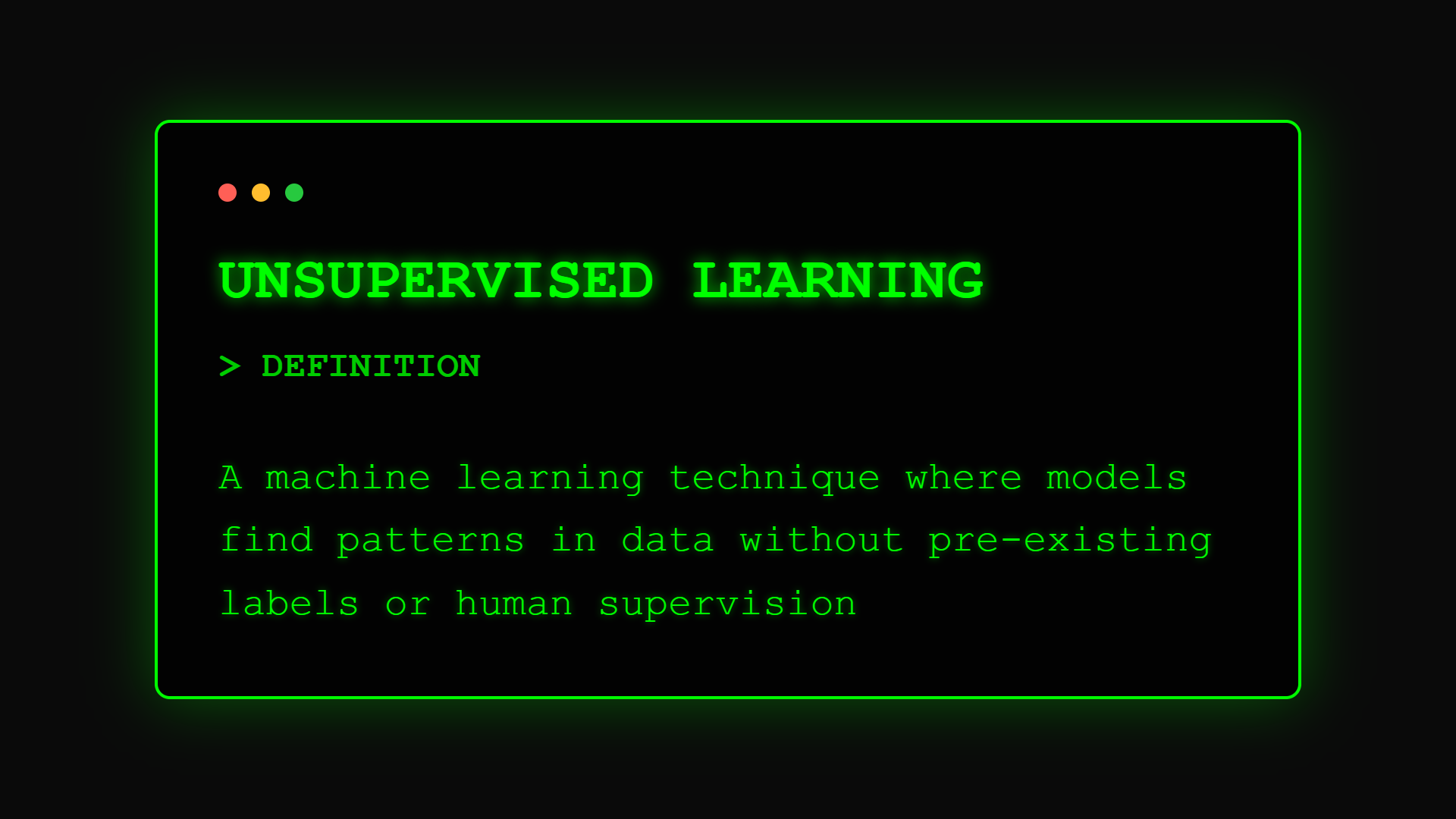AI Terms
What is Unsupervised Learning? When AI Becomes Your Data Detective

Your business generates millions of data points, but you don't know what patterns might be hiding within them. Unlike supervised learning where you teach AI with examples, unsupervised learning lets AI explore your data freely, discovering insights you never knew existed.
Technical Foundation
Unsupervised learning is a branch of machine learning where algorithms analyze unlabeled datasets to discover hidden patterns, structures, or relationships without human guidance. Unlike supervised learning that requires input-output pairs, unsupervised algorithms work with raw data.
According to Stanford's AI Lab, unsupervised learning "enables machines to identify commonalities in data and react based on the presence or absence of such commonalities in each new piece of data." The approach originated in the 1960s but gained practical significance with the explosion of unstructured data.
The mathematical foundation relies on techniques like clustering algorithms (K-means, hierarchical), dimensionality reduction (PCA, t-SNE), and generative models (GANs, VAEs) that can model data distributions.
Business Translation
For business leaders, unsupervised learning is like hiring a brilliant analyst who can sift through your data warehouse and return saying "I found something interesting you should know about" – without you having to tell them what to look for.
Imagine dropping a detective into a room full of evidence with no case file. They'd start grouping similar items, finding connections, and identifying anomalies. That's unsupervised learning – it explores your data landscape and maps the terrain.
In practical terms, this means AI that can segment your customers into meaningful groups, detect fraudulent transactions that don't match any known pattern, or identify equipment behavior that signals impending failure.
Core Capabilities
Unsupervised learning excels at these tasks:
• Pattern Discovery: Identifies recurring themes, behaviors, or structures in data that humans might miss due to complexity or volume
• Anomaly Detection: Spots outliers and unusual patterns that deviate from normal behavior, crucial for fraud detection and quality control
• Customer Segmentation: Groups customers based on behavior patterns rather than demographics, revealing unexpected market segments
• Dimensionality Reduction: Simplifies complex data while preserving important information, making it easier to visualize and understand
• Association Mining: Discovers relationships between different variables, like products frequently bought together
How It Works
The unsupervised learning process follows this pattern:
Data Ingestion: Algorithm receives raw, unlabeled data – customer transactions, sensor readings, text documents, or any unstructured information
Pattern Recognition: System analyzes data to find natural groupings, relationships, or structures using statistical methods and distance metrics
Insight Generation: Identifies clusters, anomalies, or associations that represent meaningful business insights without predetermined categories
Unlike supervised learning's clear right/wrong answers, unsupervised learning requires human interpretation to validate and act on discovered patterns.
Types of Unsupervised Learning
Different approaches serve different business needs:
Type 1: Clustering Best for: Customer segmentation, market analysis Key feature: Groups similar items together Example: Identifying customer personas from purchase behavior
Type 2: Anomaly Detection Best for: Fraud detection, quality control Key feature: Identifies unusual patterns Example: Detecting credit card fraud or manufacturing defects
Type 3: Association Rules Best for: Market basket analysis, recommendation systems Key feature: Finds items that occur together Example: "Customers who buy X also buy Y"
Type 4: Dimensionality Reduction Best for: Data visualization, feature extraction Key feature: Simplifies complex data Example: Visualizing customer segments in 2D space
Real-World Applications
Here's unsupervised learning delivering value:
Retail Example: Target uses unsupervised learning to identify customer segments beyond traditional demographics. Their algorithm discovered a "new parent" segment through purchasing patterns, enabling personalized marketing that increased revenue by 20%.
Banking Example: HSBC's anomaly detection system uses unsupervised learning to identify fraud patterns never seen before, catching 35% more fraudulent transactions than rule-based systems while reducing false positives by 60%.
Manufacturing Example: Siemens applies unsupervised learning to sensor data from industrial equipment, identifying failure patterns 45 days before breakdown without knowing what specific failures to look for.
Implementation Considerations
Key factors for success:
Data Quality: Unsupervised learning is particularly sensitive to data quality since there's no labeled data to guide learning
Interpretation Skills: Results require domain expertise to interpret and validate discovered patterns
Computational Resources: Some algorithms require significant processing power for large datasets
Business Alignment: Ensure discovered insights align with actionable business decisions
Getting Started
Ready to discover hidden patterns in your data?
- Compare with Supervised Learning to understand the differences
- Learn about Clustering Algorithms for customer segmentation
- Explore Anomaly Detection for fraud prevention
- Read our Unsupervised Learning Implementation Guide
FAQ Section
Frequently Asked Questions about Unsupervised Learning
Part of the [AI Terms Collection]. Last updated: 2025-01-11